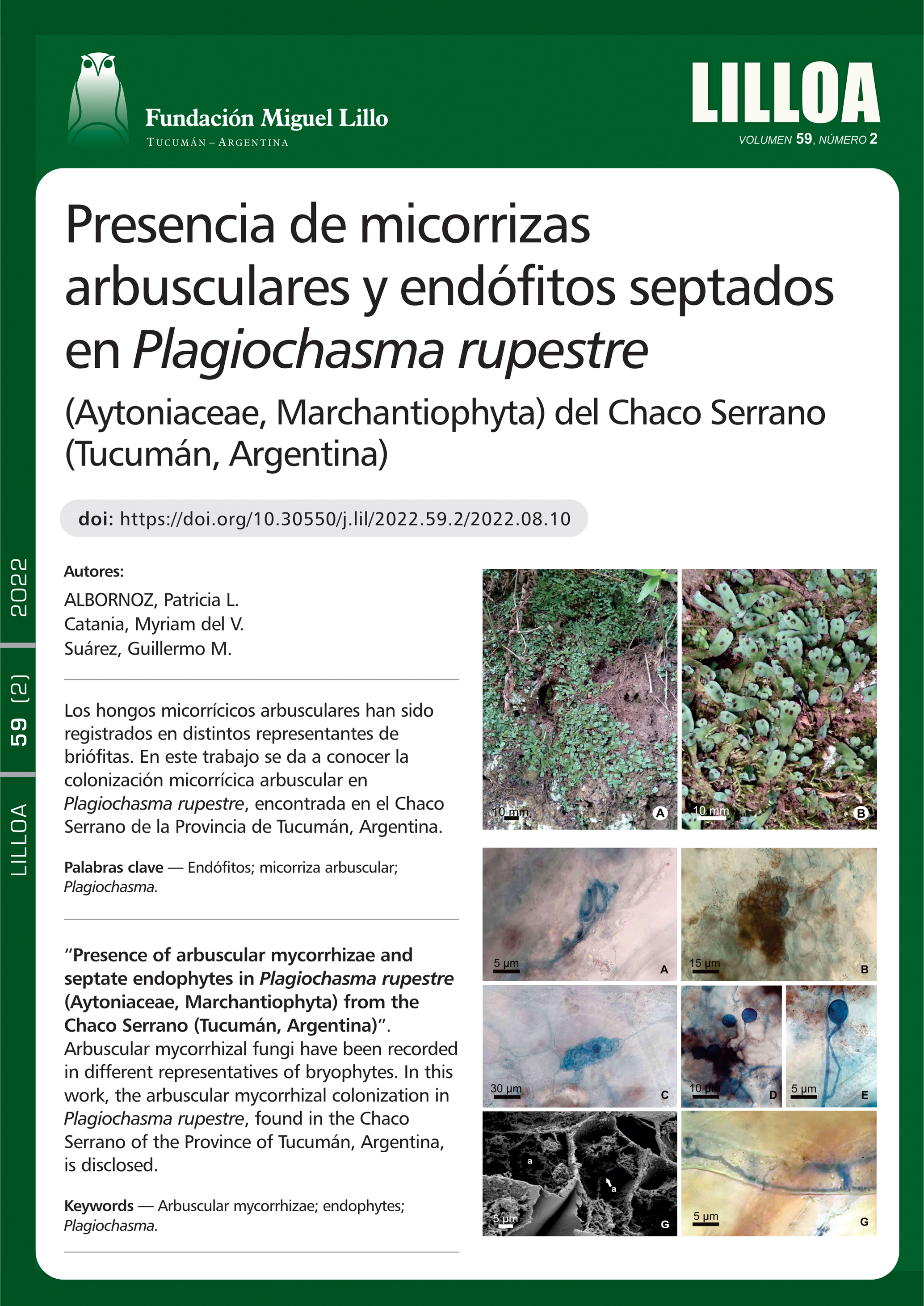Presencia de micorrizas arbusculares y endófitos septados en Plagiochasma rupestre (Aytoniaceae, Marchantiophyta) del Chaco Serrano (Tucumán, Argentina)
DOI:
Palabras clave:
endófitos, micorriza arbuscular, PlagiochasmaResumen
Los hongos micorrícicos arbusculares han sido registrados en distintos representantes de briófitas (sensu lato). En este trabajo se da a conocer la colonización micorrícica arbuscular en Plagiochasma rupestre, encontrada en el Chaco Serrano de la Provincia de Tucumán, Argentina. Además, se describen los tipos morfológicos de colonización Arum y Paris y la co-ocurrencia con endófitos septados oscuros (ESO) y hongos septados desconocidos (HSD).
Descargas
Citas
A.B.De. (2017). Association of Glomus tenue (Greenall) Hall with the hepatic Mannia fragrans (Balb.) Frye & Clark. International Journal of Advanced Research in Biological Sciences 4 (8): 51-58. DOI: http://dx.doi.org/10.22192/ijarbs.2017.04.08.008
Azcón-Aguilar, C., Jaizme-Vega, M. C. y Calvet, C. (2002). The contribution of arbuscular mycorrhizal fungi to the control of soil-borne plant pathogens. In: Mycorrhizal technology in agriculture. S. Gianinazzi, H. Schüepp, J.M. Barea, & K. Haselwandter (Eds.), pp 187-197. Birkhäuser Verlag, Germany.
Bidartondo, M. I., Bruns, T. D., Weiss, M., Sérgio, C. y Read, D. J. (2003). Specialized cheating of the ectomycorrhizal symbiosis by an epiparasitic liverwort. Proceedings of the Royal Society B, 270: 835-842.
Bidartondo, M. I., Read, D. J., Trappe, J. M., Merckx, V., Ligrone, R. y Duckett, J. G. (2011). The dawn of symbiosis between plants and fungi. Biology Letters 7: 574-577. https://doi.org/10.1098/rsbl.2010.1203
Brundrett, M.C. (2002). Coevolution of roots and mycorrhizas of land plants. New Phytologist 154: 275-304.
Carafa, A., Duckett, J. G. y Ligrone, R. (2003) Subterranean gametophytic axes in the primitive liverwort Haplomitrium harbour a unique type of endophytic association with aseptate fungi. New Phytologist 160: 185-197. https://doi.org/10.1046/j.1469-8137.2003.00849.x
Chadha, N., Mishra, M., Prasad, R. y Varma, A. (2014). Root endophytic fungi: research update. Journal of Biology and Life Science 5: 135-158. https://doi.org/10.5296/jbls.v5i2.5960
Chambers, S. M., Williams, P. G., Seppelt, R. D. y Cairney, J. W. G. (1999). Molecular identification of Hymenoscyphus sp. from rhizoids of the leafy liverwort Cephaloziella exiliflora in Australia and Antarctica. Mycological Research 103: 286-288. https://doi.org/10.1017/S0953756298007217
Cottet, A. C. y Messuti, M. I. (2017). Identificación del tipo morfológico de micorriza arbuscular en Phaeoceros laevis (Anthocerotophyta). Boletín de la Sociedad Argentina de Botánica 52 (2): 291-293.
Cottet, A. C. y Messuti, M. I. (2019). New evidence about the interactions between liverworts in the genus Symphyogyna (Pallaviciniaceae) and arbuscular mycorrhizal fungi. Symbiosis 79 (2): 117-121. https://doi.org/10.1007/s13199-019-00634-2
Cottet, A. C. y Messuti, M. I. (2022). Nuevo registro de micorriza arbuscular en Asterella chilensis (Aytoniaceae, Marchantiophyta),
Patagonia, Argentina. Boletín de la Sociedad Argentina de Botánica 57 (1): 3-7. https://doi.org/10.31055/1851.2372.v57.n1.35364
Cottet, A. C., Scervino, J. M. y Messuti, M. I. (2018). An improved staining protocol for the assessment of arbuscular mycorrhizal in
bryophytes. Boletín de la Sociedad Argentina de Botánica 53 (2): 201-206. https://doi.org/10.31055/1851.2372.v53.n2.20577
D’ Ambrogio de Argüeso, A. (1986). Manual de técnicas de histología vegetal. Editora Hemisferio Sur, Buenos Aires, 83 pp.
Dickson, S. (2004). The Arum-Paris continuum of mycorrhizal symbioses. New Phytologist 163 (1): 187-200. https://doi.org/10.1111/j.1469-8137.2004.01095.x
Estébanez, B., Draper, I. y Díaz de Atauri, R. (2011). Briófitos: una aproximación a las plantas terrestres más sencillas. Memorias de la Real Sociedad Española de Historia Natural 9: 19-73.
Field, K. J., Rimington, W. R., Bidartondo, M. I., Allison, K. E., Beerling, D. J., Cameron, D. D., Duckett, J. G., Leake, J. R. y Pressel, S. (2015). First evidence of mutualism between ancient plant lineages (Haplomitriopsida liverworts) and Mucoromycotina fungi and its response to simulated Palaeozoic changes in atmospheric CO2. New Phytologist 205: 743-756. https://doi.org/10.1111/nph.13024
Fonseca, H. M. A. C. y Berbara, R. L. L. (2008). Does Lunularia cruciata form symbiotic relationships with either Glomus proliferum or G. intraradices?. Mycological Research 112:1063-1068.
Karnovsky, M. J. (1965). A formaldehyde glutaraldehyde fixative of high osmolality for use in electron microscopy. Journal of Cell Biology 27: 137-138.
Ligrone, R., Carafa, A. Lumini, E., Bianciotto, V., Bonfante, P. y Duckett, J. G. (2007). Glomeromycotean associations in liverworts: A molecular cellular and taxonomic analysis. American Journal of Botany 94 (11): 1756-1777.
Pozo, M. J., Cordier, C., Dumas-Gaudot, E., Gianinazzi, S., Barea, J. M. y Azcon-Aguilar, C. (2002). Localized versus systemic effect of arbuscular mycorrhizal fungi on defense response to Phytophtora infection in tomato plants. Journal of Experimental Botany 53: 525-
Pressel, S., Bidartondo, M. I., Ligrone, R. y Duckett, J. G. (2010). Fungal symbioses in bryophytes: new insights in the twenty first century. Phytotaxa 9: 238-253.
Rabatin, S. C. (1980). The occurrence of the vesiculararbuscular mycorrhizal fungus Glomus tenuis with moss. Mycologia 72: 191-195.
Read, D. J., Duckett, J. G., Francis, R., Ligrone, R. y Russell, A. (2000). Symbiotic fungal associations in ‘‘lower’’ land plants. Philosophical Transactions of the Royal Sciences 355: 815-831. DOI: https://doi.org/10.1098/rstb.2000.0617
Rimington, W. R., Pressel, S., Duckett, J. G., Field, K. J., Read, D. J. y Bidartondo, M. I. (2018). Ancient plants with ancient fungi: liverworts
associate with early-diverging arbuscular mycorrhizal fungi. Proceedings of the Royal Society B 285: 20181600.
http://dx.doi.org/10.1098/rspb.2018.1600
Scagel, R. F., Bandoni, R. J., Maze, R. J., Rouse, G. E., Shoefield, W. B. y Stein, J. R. (1982). Nonvascular Plants. Wadsworth Publ. Co., Belmont, Cal., USA.
Schenck, N. C. y Pérez, Y. (1990). Manual for the identification of vesicular–arbuscular mycorrhizal fungi. INVAM, University of Florida, Gainesville.
Schüßler, A., Schwarzott, D. y Walker, C. (2001). A new fungal phylum, the Glomeromycota: phylogeny and evolution. Mycological Research 105: 1413-1421.
Silvani, V. A., Rothen, C. P., Rodríguez, M. A., Godeas, A. y Fracchia, S. (2012). The thalloid liverwort Plagiochasma rupestre supports arbuscular mycorrhiza-like symbiosis in vitro. World Journal of Microbiology and Biotechnology 28: 3393-3397. DOI 10.1007/s11274-012-1146-7
Smith, F. A. y Smith, S. E. (1997). Structural diversity in (vesicular)-arbuscular mycorrhizal symbioses. New Phytologist 137 (3): 373-388. DOI: https://doi.org/10.1046/j.1469-8137.1997.00848.x
Zhang, Y. y Guo, L. D. (2007). Arbuscular mycorrhizal structure and fungi associated with mosses. Mycorrhiza 17: 319-325. DOI 10.1007/s00572-007-0107-8
Publicado
Cómo citar
Número
Sección
Licencia
Derechos de autor 1900 Lilloa

Esta obra está bajo una licencia internacional Creative Commons Atribución-NoComercial-SinDerivadas 4.0.










